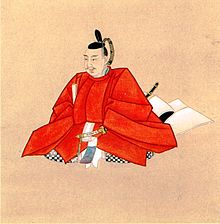Furuta Oribe
Furuta Oribe | |
|---|---|
 | |
| Nickname(s) | Oribe, Sasuke |
| Born | 1544 Motosu, Mino Province |
| Died | July 4, 1615 Fushimi, Yamashiro Province |
| Buried | |

Furuta Oribe (古田 織部, 1544 – July 6, 1615), whose birth name was Furuta Shigenari (古田 重然), was a daimyō and celebrated master of the Japanese tea ceremony.
Biography
He was originally a retainer of Oda Nobunaga and Toyotomi Hideyoshi.
His teacher in the tea ceremony was Sen no Rikyū. He became the foremost tea master in the land after Rikyū's death, and taught this art to the shōgun Tokugawa Hidetada. Among his other particularly famous tea ceremony students were Kobori Enshū and Honami Kōetsu.
The kind of tea ceremony that he established is known as Oribe-ryū (see Schools of Japanese tea ceremony), and the style of ceramics that are attributed to his artistic influence are known as Oribe ware. He also designed a style of stone lantern for the roji tea garden, known as Oribe-dōrō.[1]
During the year 1600, Oribe received a 10,000-koku income. During the Osaka Campaign of 1615, Oribe was forced to plot in Kyoto against the Tokugawa and the Emperor, on the behalf of the defenders of Osaka. After this event, Oribe was ordered to commit suicide (seppuku), along with his son.
Honours

Oribe-dō (織部堂) is a chashitsu at Nagoya Castle dedicated to his memory since he spread the practice of tea in Nagoya. The memorial hall was constructed in 1955.[2]
In media
Hyouge Mono is a Japanese manga written and illustrated by Yoshihiro Yamada. It was adapted into an anime series in 2011, and is a fictional depiction of Oribe's life.
Oribe is the subject of an advertisement by the Furuta Confectionery Company.[3]
References
- ^ Kōdansha Encyclopedia of Japan, entry for Furuta Oribe
- ^ https://www.nagoyajo.city.nagoya.jp/guide/chaseki/
- ^ R Kobayashi, フルタ製菓 古田織部好みCM, retrieved 2018-12-10
Further reading
- Nakamura Shōsei, "Furuta Oribe and Ennan," in Chanoyu Quarterly no. 17 (1977).
- Murai Yasuhiko, "Furuta Oribe," in Chanoyu Quarterly no. 42 (1985).
- Murai Yasuhiko, "Rikyū's Disciples," in Chanoyu Quarterly no. 66 (1991).
- Murase, Miyeko, ed. (2003). Turning point : Oribe and the arts of sixteenth-century Japan. New York: The Metropolitan Museum of Art.
See also
External links
 Media related to Furuta Oribe at Wikimedia Commons
Media related to Furuta Oribe at Wikimedia Commons
